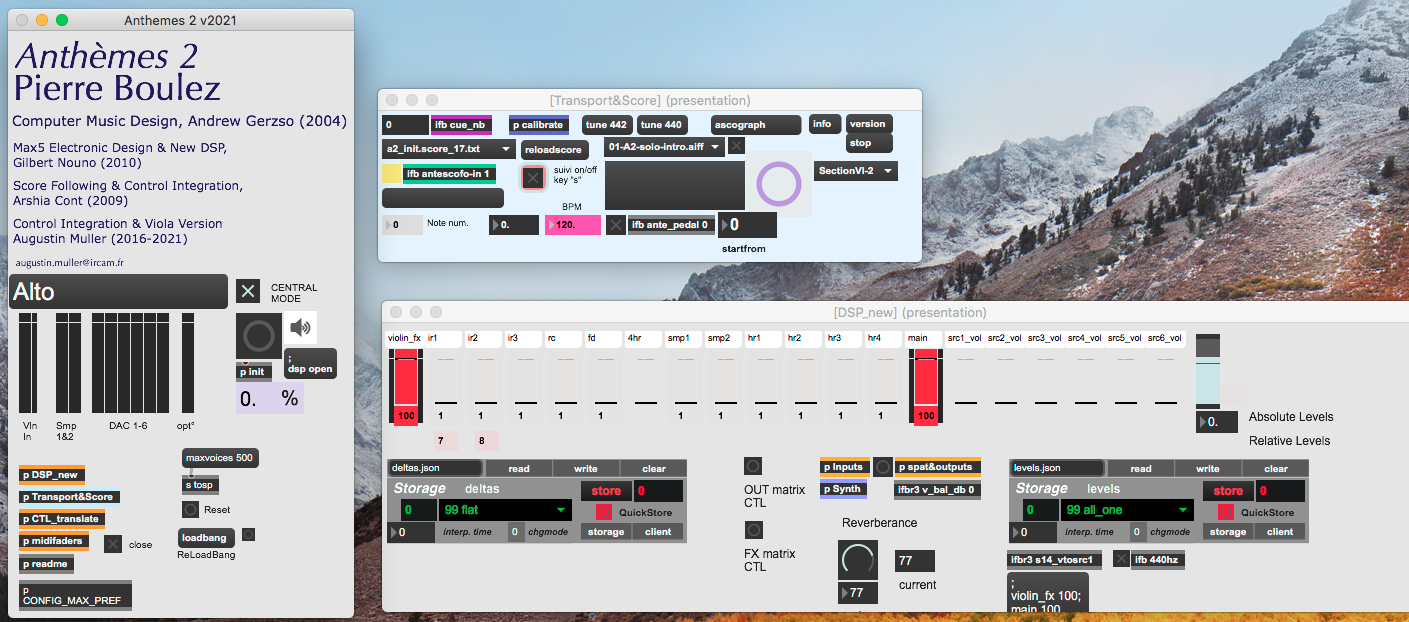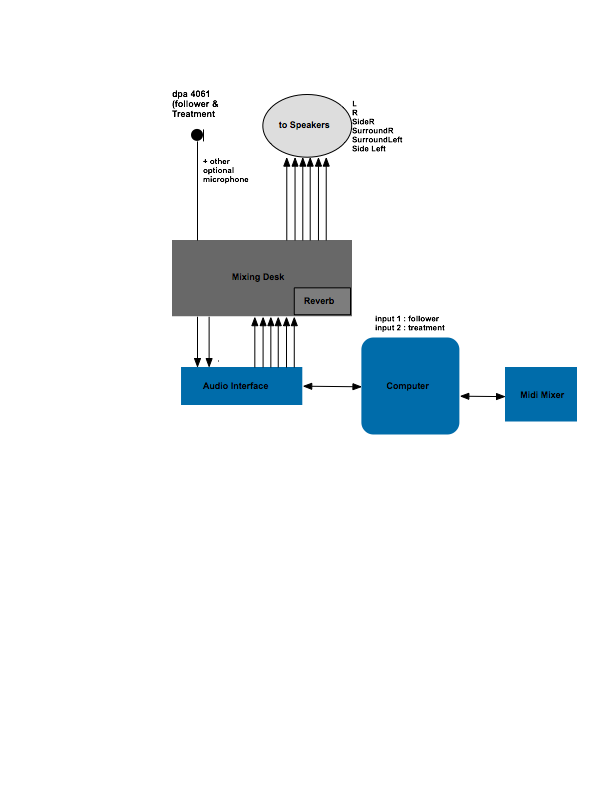Table of contents
Performance date: 30 juin 2021 - First performance
Documentation date: 10 août 2021
Version state
Valid
Validation date: 29 mars 2022
Executions dates of this version
- 30 juin 2021, Cité de la Musique
Version documentalist
- muller (Augustin.Muller@ircam.fr)
Version realisation
- Augustin Muller (Computer Music Designer)
- Odile Aubouin (Performer)
Version length
20 mnUpgrade Motivation
creation
Comment
The viola version of Anthèmes 2 features the same musical content as the violin version. Some new samples have been added to exend the register and to match the sound of the instrument, and some tempis have been precised or this version. The viola version is compatible with the violin version (only the header of the process file has to be modified to load one or the other version)
Other version(s)
Detailed staff
- alto
Channel details
- Number of input channel : 2
- Number of output channel : 6
Electronic equipment list
Audio Equipment
-
1 Microphone - Microphone
4061 on the viola -
6 Loudspeaker - Loudspeakers
6 Loudspeakers around the audience
Work related information
Premiere
- 1 janvier 2008,
Publisher :
- Universal Edition
Realisation
- Andrew Gerzso
- Gilbert Nouno
Work length
- 24 mn
Useful links on Brahms
- Anthèmes 2 version pour alto et électronique live (2008), 24mn
- Pierre Boulez
| File | Author(s) | Comment | |
|---|---|---|---|
| Download [421,1 Mio] | Patch A2_Alto_Patch | Muller |
Instructions
ANTHEMES 2 Viola - Documentation (2021)
Audio Config
6 audio outputs :surround (order of speakers according to the spat config, default : Front Left, Front Right, Side Right , Surround Right,Surround Left, Side Left)
2 audio inputs : Real Time treatments (optionally EQ+Compress) and follower (dry input)

Center Mode
In some cases, the instrumentalist may be placed at the center of the audience. In these situations, we advise to set the “center mode” at 1 in the a2_init.score_17.txt file. This option will route the “synchronous” real-time treatments on an alternate stereo output, using outs 7 & 8 . This stereo mix can be assigned to speakers placed around the player. Other sounds and fx will remain unchanged.If center mode is at 0, the system is in the classic configuration with 6 outputs as shown in the diagram, which is the advised configuration for a classic frontal stage hall.
Software installation
Put the whole folder in your max file preferences. Be sure to remove any other antescofo object from your path.
Open the patch Anthèmes2_2018_Rotterdam located in the src/main patches folder.
This patch has been played in this config: 48 kHz, IO 128, VS 64, Overdrive ON Be careful , in the patcher [CONFIG_MAX_PREF], poll and queue throttles are modified. Open
System calibration and tests
- Check antescofo version in max window -
- Check follower input in [Transport&Score[calibrate]]. For coorect following, check the calibration and make sure the signal modulates between the theshold and the top limit of the calibration module. -
- You can try some sections with a simulation in [CTL_translate] (shortcuts in transport window do not work in this version. use the simulation in [CTL_translate] or an external player, advised)
- Update the spat speakers azimuth in [CTL_translate[ Spat_configReset]] by replacing the message (louspeakers …), then hit dump, then save the patch. Main Reverberance (TR) can be chosen as well, by the spatoper interface or by message. Be sure to dump and save the patch before hitting Init! (This may change in future versions_)
Viola or Violin Mode
This version of Anthèmes 2 is compatible between viola and violin mode. To toggle from one version to another, you have to edit the header of the A2_process_17.txt :This is the viola configuration
://////////////////////////////
@transpose -700
$transposition := -7
$freqratio := 2/3
$temporatio := 0.95
$channel_offset := 20
mode “Alto”
//////////////////////////////
This is the violin configuration :
//////////////////////////////
@transpose 0$transposition := 0
$freqratio := 1
$temporatio := 1
$channel_offset := 0
mode “Violon”$
mode := “violin”/
/////////////////////////////
Initialization routine
- Check Max window and antescofo version
- Check follower input and RT input.
- Check Audio outputs config & outputs
- Choose the right interface in [midifaders]
- Hit Init or just recall init score.
- Choose the section you want to start at in transport section.
Patch presentation
The patch of Anthems is basically DSP and control interface. All the score elements, processes, data and cues are within the antescofo score. The main window gives access to IO monitoring, CPU monitoring, general config and other subpatches. It shows the instrumental loaded by the score (Violin or Viola) and shows wether Center Mode is activated or note, along with metering and cpu. In the [DSP_new] subpatch are all the effects and dsp engines, but also monitoring and interface (matrix, faders and presets) for the dsp part. In this section, you can have access to all the levels, « Deltas Levels » & Matrixes, of the patch. Matrixes and Levels should not be modified. The performance modifications should be made only on the « Deltas Levels » layer . In the [synth] subpath is located all the data and controls of the sampler. The filters can be tuned according to the hall and system. In the [Transport&Score] you will find all the antescofo environment : here you can choose a section, customize the controls for transport and interact with antescofo.

The keyboard controls for this section are the following :
- Right Arrow : nextlabel to antescofo (ie trigs next cue)
- Left Arrow : previouslabel to antescofo (no trig)
- s : toggle antescofo automatic follower on/off
- esc : stop antescofo (process& follower)
In [CTL_translate] are located some controls & utilities
- SpatOper and ctl environment - Simulation - RT controls and monitoring some translation stages between antescofo score syntax and patch syntax.
Midi Interface
The [midifaders] subpatch is where the midi controller interface can be configured and mapped. It is used for main lvl, fx, reverb and « Deltas »
Here are the midi controls used (easy to change in the abstractions [bcf2000_pscalex_01] , 3rd argument) :
- 1 main lvl
- 2 smp1
- 3 smp 2
- 4 violin fx
- 9 ir1
- 10 ir2
- 11 ir3
- 12 ringcomb
- 14 freqshiftdelay
- 15 harms
- 8 on channel 16 is reverb gain

Performance notes
Several sheet music scores are available in this distribution. Whichever is chosen to be used during the performance, it is important to have a look at the complete universal score with all the details of the electronics. It will provide precise information about the content and expectations of the electronic part.
General :
Anthemes 2 should have an acoustic, quasi intimate feel. The violin should not be amplified too loud, and therefore the electronics must be adjust to this acoustic like level. All the reverbs effects like the very beginning or the harmonics interludes should be soft but surrounding : we must feel a change in acoustical space. The pizz samples must sound precise and clear, localized and at a ƒ level (ie more like an arco level of the acoustic violin) The clouds parts (III, IV, V, VI.3) must be present but not overwhelming. Real Time treatments as harmonizers or freqshift/delays or comb must be mixed to the acoustic sound. Comb in VI.3 may be even louder. The maximum level of the piece is the « brusque » parts of 6.3
Here follows a preview of the content electronics of each part :
- Intro : Sequences (lateral) Samples to infinite reverb Reverb on violin input
- Section 1 : TR : harmonizers (located on the violin), ring-comb : (moving) TR :Samples : (moving)
- Section 2 TR : frequency-shift delays (spatialized) Samples ; sequences (cantus) spatialized;
- Section 3: TR : ring comb, spatialization Samples (hysteria, moving)
- Section 4 : TR : Spatialization : CUT DIRECT AMPLIFICATION HERE until 81, then again at the end (look at sound engineer score for more information) Samples : Shadow line, Clouds
- Section 5 : Same elements than Section 3 and 1.
- Section 6
- Section 6.1 - Samples : Klee machines ; repeating chords with shapes. Always from the back
- Section 6.2 ;
- Agité : - Samples : - chords in infinite reverb - TR : frequency-shift delay
- Calme, retenu (pizz) : - ringmod + reverb - sine chords
- Brusque : - Sequence - TR : spatialization
- Calme, regulier (rebond) - freqshift comb
- Section 6.3
- Samples : clouds in infinite reverb. focus to the central D pitch.
- NO FADE OUT before the last cue, abrupt cut
© IRCAM

This documentation is licensed under a Creative Commons Attribution-NonCommercial-NoDerivatives 4.0 International License.
Version documentation creation date: 10 août 2021 16:12, update date: 29 mars 2022 11:38